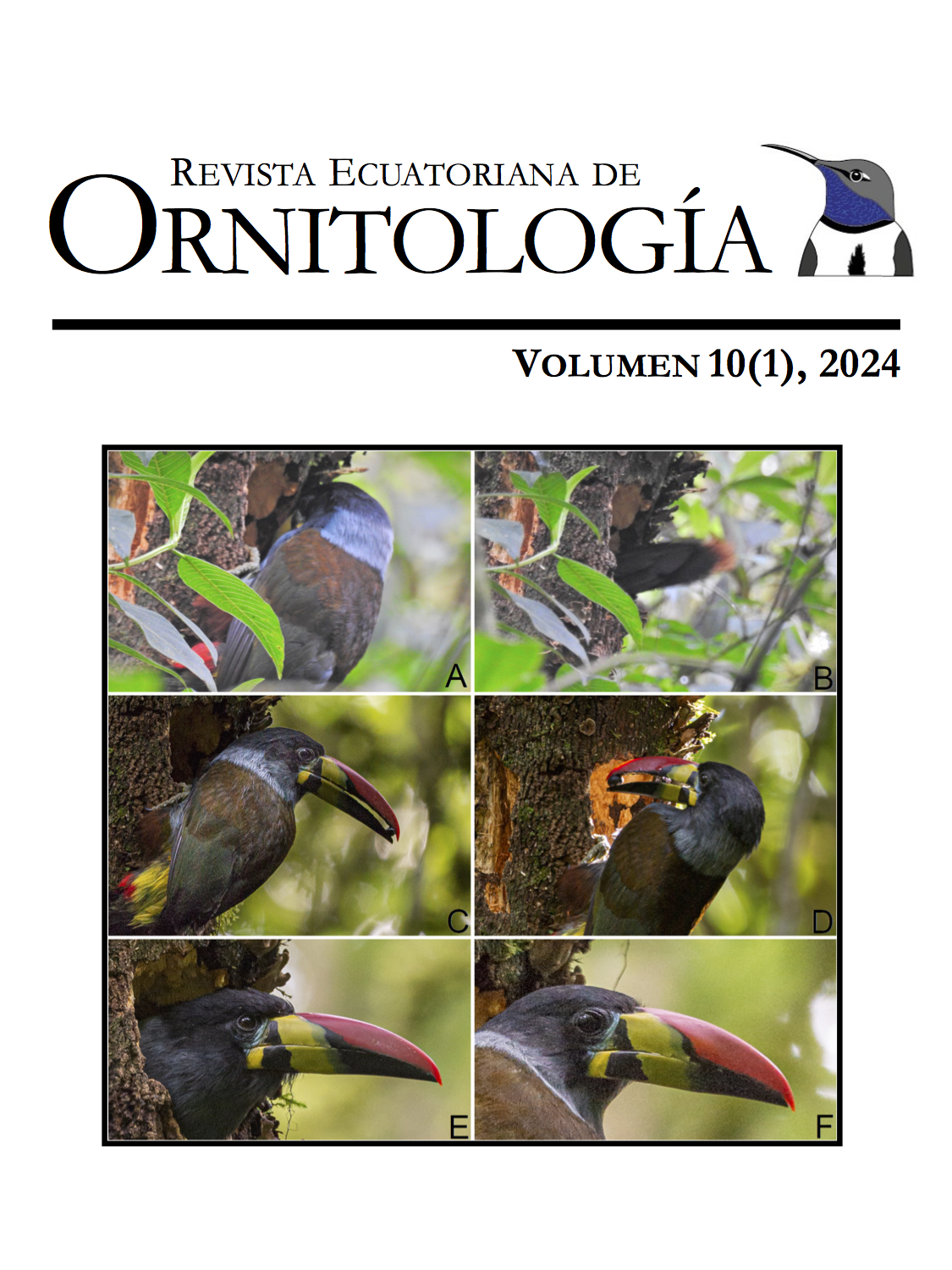Icteridae) en el nororiente del Ecuador Ver detalles 103 / 5.000 Resultados de traducción Resultado de traducción First record of Black Thrush Quiscalus lugubris (Passerine: Icteridae) in northeastern Ecuador
DOI:
https://doi.org/10.18272/reo.v10i1.3086Keywords:
First RecordAbstract
El Clarinego Negro Quiscalus lugubris se está dispersando rápidamente por la Amazonía norte del Ecuador. En esta nota presento los primeros reportes en las provincias de Sucumbíos y Orellana, entre octubre y diciembre de 2022.
Downloads
References
Aguilar, J. M. & Freile, J. F. & Tinoco, B. A. (2016). Rapid colonization of Ecuador by the Tropical Mockingbird (Mimus gilvus). Ornitologia Neotropical, 27, 155–162. DOI: https://doi.org/10.58843/ornneo.v27i0.51
Didham, R., Tylianakis, J., Gemmell, N., Rand, T., & Ewers, E. (2007). Interactive effects of habitat modification and species invasion on native species decline. Trends in Ecology and Evolution, 22, 489–496. DOI: https://doi.org/10.1016/j.tree.2007.07.001
eBird. (2023). eBird: an online database of bird distribution and abundance. Ithaca, NY: Cornell Lab of Ornithology. URL: https://ebird.org
Fraga, R. (2020). Carib Grackle (Quiscalus lugubris) version 1.0. En J. del Hoyo, A. Elliott, J. Sargatal, D. A. Christie & E. de Juana (Eds), Birds of the World. Ithaca, NY: Cornell Lab of Ornithology. DOI: https://doi.org/10.2173/bow.cargra1.01
Hualinga, P. & Aguilar, M. (2022, Octubre 3). eBird checklist: https://ebird.org/checklist/S120306593. eBird: an online database of bird distribution and abundance. Ithaca, NY: Cornell Lab of Ornithology. URL: https://ebird.org
Nilsson, J., Freile, J. F., Ahlman, R., Brinkhuizen, D. M., Greenfield, P. J., & Solano-Ugalde, A. (2014). Rare birds in Ecuador: second annual report of the Committee for Ecuadorian Records in Ornithology (CERO). Revista Avances en Ciencias e Ingenierías, 6(2), B38–B50. DOI: https://doi.org/10.18272/aci.v6i2.178
Restall, R., Rodner, C. & Lentino, M. (2006). Birds of northern South America: an identification guide. volume 1. Species accounts. Londres, Reino Unico: Christopher Helm.
Salaman, P., Stiles, F. G., Bohórquez, C. I., Álvarez, M., Donegan, T. & Cuervo, A. M. (2002) New and noteworthy bird records from the Andean East slope of Colombia. Caldasia, 24, 157–189. URL: https://revistas.unal.edu.co/index.php/cal/article/view/39439/41330
Strewe, R., León, C. V., Lobatón, G., Morales, A., & Ayerbe, F. (2006). Ampliación del rango de distribución del chango llanero Quiscalus lugubris (Icteridae) en Colombia. Revista Intrópica, 3, 109–112. URL: https://revistas.unimagdalena.edu.co/index.php/intropica/issue/view/26
Young, K. R. (2009). Andean land use and biodiversity: humanized landscapes in a time of change. Annals of the Missouri Botanical Garden, 96, 492–507. DOI: https://doi.org/10.3417/2008035
Downloads
Published
How to Cite
Issue
Section
License
Copyright (c) 2024 Gabriel Enrique Maldonado Casanova

This work is licensed under a Creative Commons Attribution-NonCommercial 4.0 International License.
Los autores que publiquen en la Revista Ecuatoriana de Ornitología aceptan los siguientes términos:
- Los autores/as conservarán sus derechos de autor y garantizarán a la revista el derecho de primera publicación de su obra, el cuál estará simultáneamente sujeto a la Licencia de Reconocimiento No Comercial de Creative Commons.
- Los autores/as podrán adoptar otros acuerdos de licencia no exclusiva de distribución de la versión de la obra publicada, pudiendo de esa forma publicarla en un volumen monográfico o reproducirla de otras formas, siempre que se indique la publicación inicial en esta revista.
- Se permite y se recomienda a los autores difundir su obra a través de Internet en su repositorio institucional, página web personal, o red social científica (como ResearchGate o Academia.edu).


